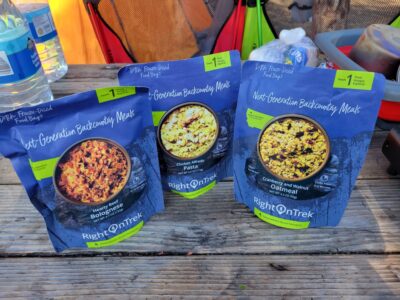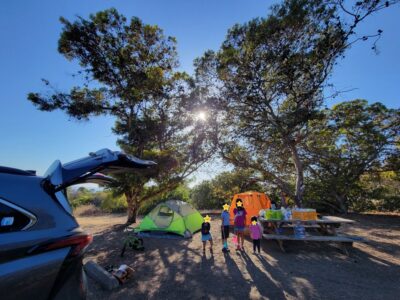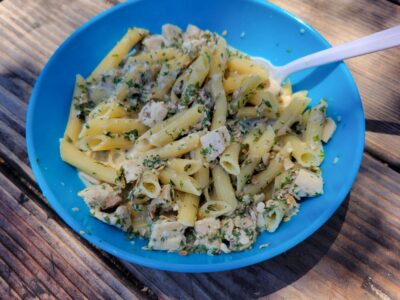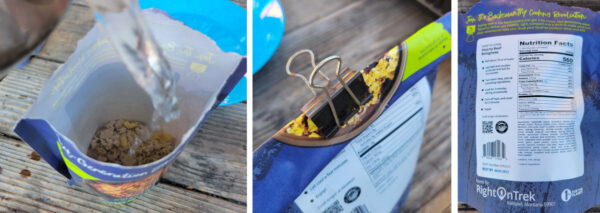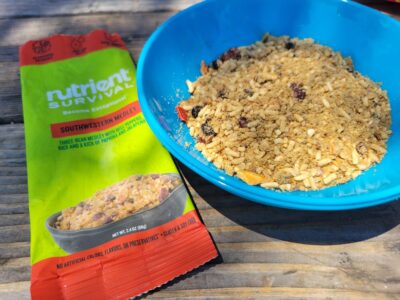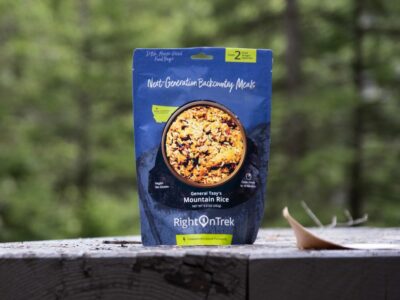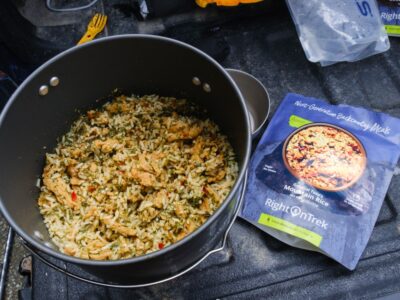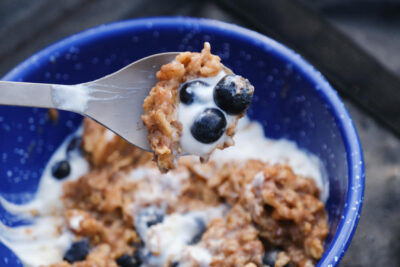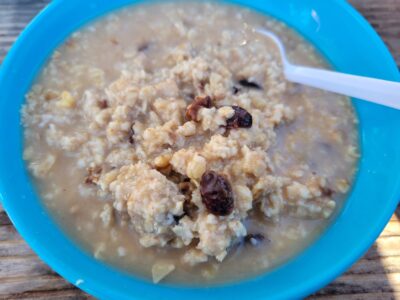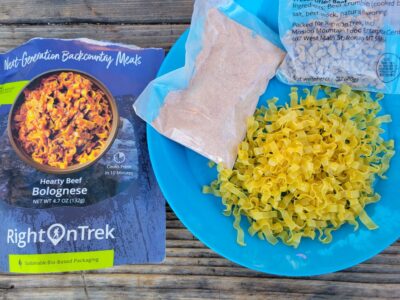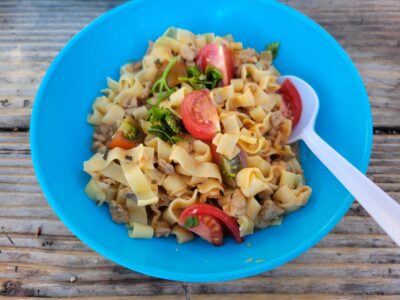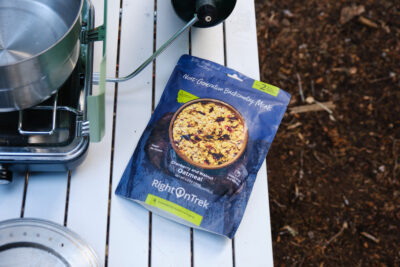RightOnTrek Backpacking Food
Pros
- Excellent taste
- Healthier ingredients and less sodium
- 18-month shelf life
- Environmentally-friendlier packaging
- Lightweight
Cons
- Best when cooked in pot, not bag
- Only 4-person bags are currently resealable
- Shorter shelf life than Mountain House's 30 years
- Needs access to water
- Not yet widely available in stores
Contents
Worthwhile Mountain House Alternative
My friends, family, and I have been hiking, camping, and wilderness backpacking for over a decade, and one staple item we bring along is freeze-dried food. They are lightweight meals that can have a shelf life of up to 30 years, making them perfect for emergency preparedness because all they need is water to rehydrate. Mountain House makes some of our FAVORITE food (see list here) and is perhaps the de facto company that backpackers recognize worldwide. Thus, there is little surprise that more brands, like Backpacker’s Pantry, Peak Refuel, Good To-Go, and Readywise, are jumping onto the train. Can you imagine having Chicken Pho, a Vietnamese noodle soup, in the middle of nowhere?
RightOnTrek, a 20-50 employee, Kalispell, Montana, company founded in late 2018, approached me a couple months ago to try out their offering. Initially, I intended to decline, but after reading their website, mission statement, food and services offered, I was intrigued because they stood for what I, personally, have also been believing in: to introduce backpacking and outdoor adventures to people through sharing of knowledge, experience, stories, and equipment. What particularly caught my eyes were their website’s free trail, backpacking, and meal planning tools — AND they also provided a gear renting service at Glacier National Park, Montana, where everything you needed to go into the wilderness was available for pickup. Mountain House, a 200-500 employee brand founded in 1969 and owned by Oregon Freeze Dry (OFD), did not offer such a range of extra services besides freeze dried meals.
Backpacker Magazine, one of my favorite outdoor publications, rated RightOnTrek’s Bechamel Style Mac and Cheese as the “Best Dehydrated Macaroni and Cheese” (June 2022). “Send me a sample of your meals”, I told RightOnTrek, and under one condition: they cannot influence or change what we write in this article. They happily obliged. The below packages were delivered and this article will be updated as we try them. (Hey, why didn’t you send your Mac and Cheese?)
Disclosure: We received the above-listed products free in exchange for an honest, unbiased opinion, whether positive or negative. We test each product thoroughly, give high marks to only the very best, and the views expressed here are honest and our own. Learn more
What Will Be Covered Here
In this review, we will go over:
- Comparison with Mountain House as it relates to Ingredients and Nutrition, Packaging, and Cooking Preparation
- What Freeze-Dried food is
- Taste Impressions of various RightOnTrek meals
Food Analysis
Let me be clear: I did NOT expect much from RightOnTrek. What could a small company do that well-known Mountain House, a brand with 10x as many employees, could not? My friends and I love Mountain House for backpacking or extended hikes — so much so, we even compiled a list of our Mountain House favorites and not-so-favorites! As it turns out, a lot.
My best friend, our children, and I recently went camping at a picturesque Santa Barbara, California, State Beach. Our mission was clear: try out new cooking techniques and meals, like using a cast iron pan and roasting a chicken (took 2 hours! Secure like this) directly over campfire, for future camping and trekking trips. That gave us the opportunity to taste test RightOnTrek’s “Cranberry and Walnut Oatmeal”, “Hearty Beef Bolognese”, and “Chicken Alfredo Pasta”. How did it go? In short: “Wow!” I am not saying this because we got the meals for free — we even declined to sign up for their affiliate program at the time. No, we genuinely did not imagine them tasting so good that our children (and I) asked for more!
Note: We originally did not plan to write a long review for RightOnTrek, but their meals were so good and their philosophy resonated with us just as much, we wanted to share the experience with our readers and spread the word.
Ingredients and Nutrition
Before I share with you a bite ;) of each meal’s impression, I wanted to first discuss the ingredients and nutritional facts we found to be common across all the packages.
Many had organic ingredients, and most were not salty or overly sweet. Let that sink in. Mountain House usually is quite salty — perhaps to aid with putting sodium back into one’s fatigued body during a multi-day trek — but we prefer being able to control the amount we consume while on the trail.
Many had organic ingredients, and most were NOT salty or overly sweet. Let that sink in.
What I found interesting was that NOT the entire meal’s content was freeze-dried like Mountain House and others. RightOnTrek claimed that they air dry as much as possible to better lock in the flavors and nutrients. Does freeze drying really destroy nutrients, and if so, by how much? According to my research, the amount lost is negligible (less than 3%) due to how quickly food goes from cooked to frozen and then dried in the process (see our “What is Freeze-Dried Food?” section below for more information.) Did RightOnTrek’s meals taste better? Surprisingly and with much delight, the initial ones we tried were VERY good. So much so, that my best friend, our children, and I wanted more. That’s no joke! Did air drying really make THAT much of a difference? Turns out, no. Upon closer inspection, I found a big distinction from Mountain House: not all of RightOnTrek’s ingredients had yet been cooked! Why would that matter?
When food is freeze dried, it had already been cooked once, may have preservatives added, and is then re-hydrated with hot water for 10-20 minutes inside the packaging. RightOnTrek’s, however, was not meant to be cooked inside the bag. After years of being conditioned to bring dried food back to life with boiling water, this company’s meals were actually meant to be prepared — with either hot or cold water, depending on the food — in a pot or pan as if you were making dinner from scratch. On one hand, the meals we tried indeed tasted incredibly good, but on the other, we had to wash a pot afterwards. We did try to pour boiling water directly into the Chicken Alfredo Pasta’s bag, and although the pasta was slightly undercooked after 10-15 minutes, it did not take away from the taste!
RightOnTrek’s meals are not meant to be cooked inside their bags, but in pots or pans for a more “fresh” taste. They cautioned: “[B]ecause our bags [are] bio-based and compostable… if you were to add hot water to the bags, [they] will start to deteriorate as they are supposed to. Cooking in the pot allows [the] meals to rehydrate more evenly, [have] better retention of nutrients, [and have] much better taste.” They added that cooking “is required since not all ingredients are freeze-dried.”
There is one caveat to not fully freeze dry an entire package: RightOnTrek’s shelf life was just 18 months compared to Mountain House’s 30 YEARS! So, for us, the choice was clear: either company’s products would be our pick for trips, but Mountain House’s would be stashed within our bug out emergency bags. One should note that RightOnTrek’s meals had healthier ingredients.
The company goes through a “highly selective curation process” to source its ingredients from “smaller, organic top-grade farms”, it shared. I could not independently verify that claim.
Packaging
Immediately noticeable between RightOnTrek and Mountain House’s packaging is that the latter is sturdier, has a silver interior lining, and is resealable — qualities that have made their meals so popular among backpackers like myself because food can be re-hydrated/heated directly inside the bag. Unfortunately, they cannot be burned — plastic is harmful — and must be brought back so no trash is left out in the wilderness. In fact, I had thrown a few into the fire long time ago and found that they never fully burn away, potentially leaving toxic substances behind. But do not worry — I practice the “Leave No Trace” outdoor ethic and took it back with me to ensure the land can be enjoyed by many more generations to come.
RightOnTrek’s packaging had no plastic, glossy feeling and did, in fact, worry me about how rugged it might be to withstand the backcountry. It was nowhere as puncture resistant as Mountain House’s, but it surprisingly held up well inside a packaged backpack. The company’s website detailed that their packages were “100% bio-based, 60% compostable with material derived from tree-pulp.” They felt lighter, held boiling water just fine, and burnt fully in our campfire with no plastic or toxic-smelling smoke. They were priced about the same as Peak Refuel, but generally less than Mountain House.
Packages are “100% bio-based, 60% compostable” and our samples fully burnt up with no plastic or toxic-smelling smoke. RightOnTrek is working to make them 100% compostable.
A growing trend in the positive direction is the availability of packages with different portion sizes. Gone are the days when Mountain House used to offer predominantly two-serving sized meals that my best friend and I used to split on the trail, and felt more like 1.5 servings after a long day of hiking. RightOnTrek, at the time of this writing, offered portions for one, two, and four persons. The company told me that customer feedback, including from me, requested resealable bags for the two- and one-person portion and may consider doing so. The four-person one already is resealable.
Inexplicably, among RightOnTrek, Mountain House, Backpacker’s Pantry, Peak Refuel, Good To-Go, and Readywise, only RightOnTrek and Peak Refuel’s packages include a photo of the cooked content to give the customer a glimpse of what to expect. The other brands’ lack of such inclusion takes away their soul as if to hide the unappetizing look that some of the freeze-dried meals, especially rice dishes, may look like. Take a look at the Nutrient Survival Southwestern Medley photos! Besides the extra water we added, does it look yummy? (None of us liked it.)
Cooking Preparation
One of the first meals we tried from RightOnTrek was its Chicken Alfredo Pasta, and little did we know that adding boiling water and letting sit for 10-15 minutes was not the manufacturer’s recommended method of cooking. The food was meant to be prepared in a pot or pan because the company claimed faster cooking time, better taste, and less loss of nutrients. So, what that means for backpackers is one additional dish to clean and perhaps one extra item to carry. If that is the sacrifice one must make to get “fresher” tasting meals out in the wilderness, that may be a worthwhile inconvenience to consider. Cooking in a pot also ensures the food stays warm instead of getting cold inside the bag at higher elevations or colder environments.
“Our meals were originally designed for guides who want to provide their clients the best eating experience they can. So, they’re all meant to be eaten out of a separate dish.” -RightOnTrek
RightOnTrek cautioned: “[B]ecause our bags [are] bio-based and compostable… if you were to add hot water to the bags, [they] will start to deteriorate as they are supposed to. Cooking in the pot allows [the] meals to rehydrate more evenly, [have] better retention of nutrients, [and have] much better taste.” They added that cooking “is required since not all ingredients are freeze-dried.”
There may be a potential workaround to try: what if you threw the RightOnTrek content and water into an empty Mountain House bag (or bowl you would be eating from) and bathe it in a boiling pot — sous vide style? The Mountain House bag (or bowl) should be easier to clean than a dirty pot, and you would still have a nicely cooked RightOnTrek meal. Synergy between both brands ;-)
What is Freeze-Dried Food?
Whenever I introduce them to my friends, they immediately think of MRE’s — Meals Ready To Eat — common with the military. I had my first taste of MRE’s over 10 years ago and did not like them. The premise was great though: open the MRE and start eating. No cooking necessary. But they usually did not taste good. Perhaps things have changed, but I had never tried them again since.
To preserve food without needing refrigeration, there are multiple options: Dehydrating (think beef jerky), baking, smoking, preserving, canning, etc. PROBLEM with those methods? They all change the way the food will taste. Too salty, too dry, too yucky, etc. Then there are some where the food could get warmed by a chemical reaction that you activate with the package, but those are heavy and difficult to dispose of while out in the wilderness.
Freeze drying, on the other hand, is a long process whereby the food has its water removed, maintaining its natural composition and keeping its flavor, vitamins, and nutrients. I will cover what that process is like shortly, but the important part to remember is: the taste remains essentially unchanged AND the meal is much lighter to carry around. They also cost a lot.
Taste remains essentially unchanged AND the meal is much lighter to carry around.
Have you heard of “Astronaut food”? NASA popularized freeze-dried food with the introduction of ice cream that did not need refrigeration. Note: industrial freeze drying could date back as early as the 1800’s, but the idea has been attributed as far back as the Incas of the 13th century.
Freeze-Drying Process
How does food get freeze-dried? The cooked meal is first frozen, then placed in a chamber where the atmospheric pressure is less than 1 ATM (lower than the natural pressure we experience at sea). Over the next 18-20 hours, the food is heated at a very low temperature, and because the pressure is less than normal, ice skips becoming a liquid and jumps straight to gas. That gas is then sucked out. It requires a lot of energy — more than the other forms of preservation. The end result: we are left with food that has no water left, and as such, makes it much lighter to carry and more difficult for any micro organism to spoil. For that reason, freeze dried food can be kept for a minimum of 30 years when stored properly in an air-tight, dry, dark place (and a desiccant to absorb any moisture that might be trickling in). To eat (or drink), simply add back water.
Freeze drying is a long, costly process.
One should note that freeze-drying does NOT kill all bacteria or viruses. They may simply lay dormant (NIH), and as such, the food should still be cooked or reheated properly.
Taste Impressions
Let’s look at the individual meals we had tried!
Cranberry and Walnut Oatmeal
Oatmeals are healthy for you. I used to have a Quaker Oats package every day for breakfast but stopped long ago because they were too sweet. With that expectation in mind, I boiled some water and added it to RightOnTrek’s package, let sit for 5 minutes, and portioned for four children and two adults to try. My best friend took the first bite and said, “Mmm… I like it!” He regularly eats oatmeal at work. It was not very sweet — something both he and I much prefer — and the walnuts and cranberries added a bit of nutty bitterness and sour to each bite. It was actually very fun to consume the cinnamon-sprinkled oatmeal.
The texture was what one would expect from putting oatmeal, walnuts, dried cranberries, and powdered cinnamon together at home. Adding honey while out in the wilderness would provide some welcome sweetness to a power breakfast.
Cooking Preparation: Cook in boiled water for 3 minutes. Although RightOnTrek expects preparation in a pot, we did it in the package itself. More info: Amazon / RightOnTrek
Chicken Alfredo Pasta
This was one of our favorites. In fact, as I was writing this part of the review, my little son was sitting next to me and pointed out that “it was really yummy.” The uncooked content was very unassuming and unappetizing with just penne pasta, a bag of freeze-dried chicken cubes, and white powder sitting on the plate. Once boiled water was added to the bag and let sit for 10 minutes, the parsley greens started to stand out and mushroom and finely chopped onions took shape. The resulting meal looked very appetizing and far different from what we ever had from Mountain House.
Each peppery bite tasted quite fresh and was accented by some garlic and creamy alfredo. It would have been creamier had we not added as much water as we did, but old habits die hard: we tend to make our meals a bit more soggy while backpacking for some extra flavored, liquid replenishment.
One should note that we did not prepare the meal in a pot as per the manufacturer’s recommendation because we boys did not read the instructions. Instead, we simply added boiled water into the bag and should have let sit for 15 minutes instead of ten — the pasta was a tad undercooked but still delicious.
Cooking Preparation: Cook in pot with boiled water. Ready to eat in 5 minutes. More info: Amazon / RightOnTrek
Hearty Beef Bolognese
For the last meal in our first batch of taste tests, I wanted to incorporate some fresh ingredients from my Costway car freezer: cherry tomatoes and chopped parsley. Our children devoured this one FAST and rightfully so! The tagliatelle pasta paired with generous portions of ground beef, tomato flavoring, and parmesan cheese was quite delicious and filling. One of the kids licked the leftover sauce off the plate.
Contrary to instructions, we added boiled water directly into the bag and let sit for 20 minutes. RightOnTrek recommends cooking in a pot instead.
Cooking Preparation: Cook in pot with boiled water. Ready to eat in 7-10 minutes. More info: Amazon / RightOnTrek
Final Thoughts
We are excited… very excited! With competition heating up in the meals-to-go space and more individuals getting serious about emergency preparation, we have noticed a sharp upward trend in the number of related products sold, including power stations, solar panels, and overlanding/boondocking vehicles and accessories. Increased players in this field inevitably leads to better choices, innovative products and services, and prices for consumers, and we love seeing our culinary options expanded for future wilderness excursions!
RightOnTrek’s meals added a new perspective to my backpacking food knowledge in that Mountain House is not the only choice for lightweight, nutritious meals for the trails. They had me started asking questions like, “Why not bring healthier options along?” Mountain House’s food started tasting similar over the years and the amount of salt they added was always a concern unless enough calories were expended to justify it. With the first batch of taste tests hitting home runs for my best friend, our children, and I, we just had to share the experience with our readers and promote what RightOnTrek has to offer. I was told that discussions with retailers, including REI, are in the works.
We are rooting for you, RightOnTrek! Bring some more healthier, delicious meal choices to backpackers/ trekkers domestically and internationally. We look forward to seeing how you could poke the other brands to consider doing the same.
Where To Buy
- RightOnTrek
- General Tsoy’s Mountain Rice (Amazon, RightOnTrek) / Vegan Shepard’s Stew (Amazon, RightOnTrek)
- Chicken Alfredo Pasta (Amazon, RightOnTrek) / Chicken Coconut Curry (Amazon, RightOnTrek)
- Backcountry Chili (Amazon, RightOnTrek) / Hearty Beef Bolognese (Amazon, RightOnTrek)
- Bechamel Style Mac and Cheese (Amazon, RightOnTrek) / Cranberry and Walnut Oatmeal (Amazon, RightOnTrek)
- Cheesy Mushroom Egg Scramble (Amazon, RightOnTrek)
- Other Brands: Mountain House / Backpacker’s Pantry / Peak Refuel / Good To-Go / Readywise
Related Posts
- Review: Mountain House Granola with Milk & Berries + Bonus: Our Favorite Meals List
- Chill Pal Mesh vs PVA Cooling Towels for Hiking, Camping, Travel
- Temperature Control
- Mr. Heater Buddy Indoor-Safe Portable Propane Radiant Heater
- Outland Living Firebowl Propane Fire Pit (893 Deluxe) with Refillable Tank
- EcoFlow Wave Portable Air Conditioner
- Lighting
- Devos LightRanger 2000 vs 1200: Bright, portable, compact, full-coverage area light with battery and stand. Now brighter with remote control, built-in colored LEDs
- Devos LightRanger 1200: Portable, compact, full-coverage area light with battery and stand
- Goal Zero Skylight: Heavy-duty, bright, portable, full-coverage area light with battery and stand
- Cooking
- ICECO 15.7″ Foldable Charcoal Grill – Compact for Tabletop
- Tomshoo vs Solo Stove Camping Stove
- Osba 1L Travel Rice Cooker 12V (2-4 Cups) For Cars (CFXBOB-MR C2)
- Power Stations / Solar Panels / Car Freezers
Our RightOnTrek Recommendations
My friends and I have been backpacking for a long time and have tried many packable meals and brands. Here are our recommendations for RightOnTrek (will be updated as we try new meals). You may also want to refer to our list of Mountain House Favorites.
Tip: Add olive oil to further enhance the flavor!
Tasty
- Chicken Alfredo Pasta (Amazon, RightOnTrek)
- Cranberry and Walnut Oatmeal (Amazon, RightOnTrek)
- Hearty Beef Bolognese (Amazon, RightOnTrek)




